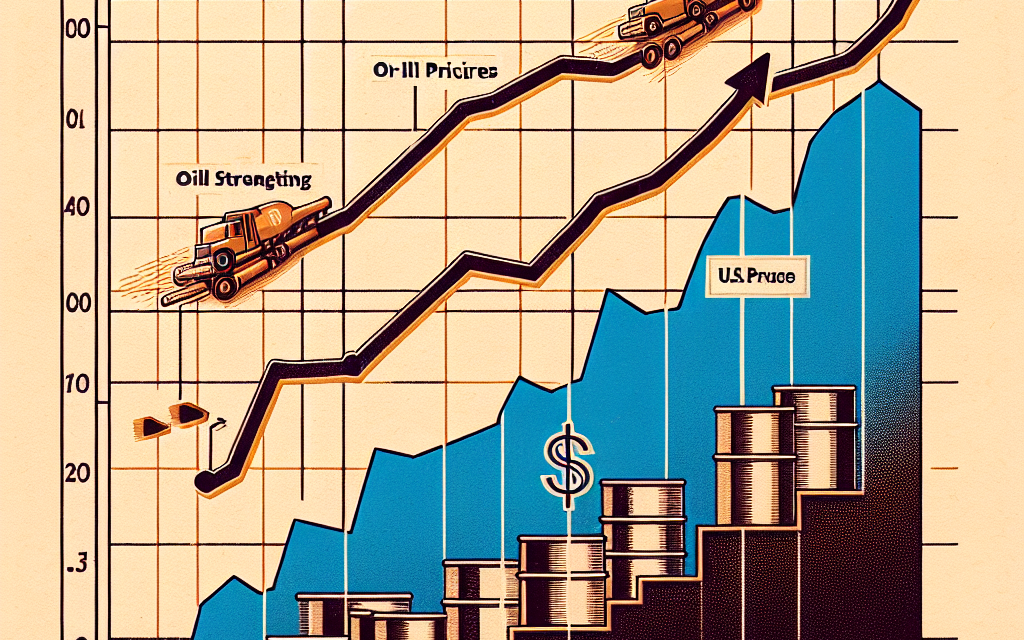“Oil Prices Drop as Dollar Gains Ground and U.S. Fuel Inventories Surge.”
Introduction
The recent decline in oil prices can be attributed to a combination of factors, notably the strengthening of the U.S. dollar and rising fuel inventories in the United States. As the dollar gains strength, oil, which is priced in dollars, becomes more expensive for foreign buyers, leading to decreased demand. Simultaneously, an increase in U.S. fuel inventories signals a surplus in supply, further exerting downward pressure on prices. This dynamic interplay between currency fluctuations and inventory levels is reshaping the landscape of the global oil market, prompting analysts to reassess future price trajectories and the broader economic implications.
Oil Prices and Dollar Correlation
In recent weeks, the correlation between oil prices and the strength of the U.S. dollar has become increasingly evident, as fluctuations in currency value have a direct impact on global oil markets. As the dollar strengthens, oil prices tend to decline, creating a dynamic interplay that reflects broader economic conditions. This relationship is particularly pronounced in the context of rising U.S. fuel inventories, which further contribute to downward pressure on oil prices.
The U.S. dollar serves as the primary currency for oil transactions worldwide, meaning that any appreciation in the dollar makes oil more expensive for holders of other currencies. Consequently, when the dollar gains strength, demand for oil can diminish, leading to a decrease in prices. This inverse relationship is not merely theoretical; it is supported by empirical data that shows how shifts in currency value can influence market sentiment and trading behavior.
Moreover, the recent rise in U.S. fuel inventories has compounded the effects of a stronger dollar on oil prices. As inventories increase, it signals an oversupply in the market, which can lead to further price declines. The U.S. Energy Information Administration (EIA) has reported significant builds in crude oil and gasoline inventories, indicating that domestic production levels are outpacing consumption. This oversupply scenario, coupled with a robust dollar, creates a challenging environment for oil prices, which are already under pressure from various geopolitical and economic factors.
In addition to these fundamental dynamics, market participants are closely monitoring global economic indicators that can influence both the dollar and oil prices. For instance, economic growth in major economies can lead to increased demand for oil, while signs of economic slowdown can have the opposite effect. As investors assess these indicators, they often adjust their positions in anticipation of future movements in both currency and commodity markets. This behavior underscores the interconnectedness of global finance, where shifts in one area can reverberate across others.
Furthermore, geopolitical tensions and OPEC’s production decisions also play a crucial role in shaping the oil market landscape. While a stronger dollar and rising inventories may exert downward pressure on prices, any disruptions in supply due to geopolitical events or changes in OPEC’s output can create volatility. Traders must navigate this complex environment, balancing the influences of currency strength, inventory levels, and geopolitical risks in their decision-making processes.
As we look ahead, the outlook for oil prices will likely remain influenced by the ongoing strength of the U.S. dollar and the trajectory of fuel inventories. Should the dollar continue to appreciate, it may further suppress oil prices, particularly if inventory levels remain elevated. Conversely, any signs of a weakening dollar or a reduction in inventories could provide support for oil prices, creating a more favorable environment for producers.
In conclusion, the correlation between oil prices and the strength of the U.S. dollar is a critical factor in understanding the dynamics of the global oil market. As the dollar strengthens and U.S. fuel inventories rise, the resulting pressure on oil prices highlights the intricate relationships that define commodity trading. Market participants must remain vigilant, as shifts in these variables can lead to significant changes in the economic landscape, influencing both short-term trading strategies and long-term investment decisions.
Impact of Rising U.S. Fuel Inventories
The recent decline in oil prices can be attributed to a confluence of factors, with rising U.S. fuel inventories playing a pivotal role. As the United States continues to ramp up its production capabilities, the increase in fuel inventories has created a surplus that directly impacts market dynamics. This surplus, in turn, exerts downward pressure on oil prices, as supply outstrips demand. Consequently, the relationship between inventory levels and pricing becomes increasingly significant, particularly in a market that is sensitive to fluctuations in supply and demand.
To understand the implications of rising fuel inventories, it is essential to consider the broader context of the oil market. The U.S. has emerged as a dominant player in global oil production, largely due to advancements in extraction technologies such as hydraulic fracturing and horizontal drilling. These innovations have enabled the country to tap into previously inaccessible reserves, resulting in a substantial increase in crude oil output. As production levels rise, so too do the inventories, which are stored in various facilities across the nation. This accumulation of fuel not only reflects the current state of production but also signals expectations for future demand.
Moreover, the increase in U.S. fuel inventories coincides with a period of economic uncertainty, which has led to a cautious approach among consumers and businesses alike. As economic indicators fluctuate, the demand for fuel tends to wane, further exacerbating the situation. When consumers anticipate a slowdown in economic activity, they are less likely to engage in travel or consumption that requires fuel, leading to a decrease in demand. This decline in consumption, coupled with rising inventories, creates a scenario where oil prices are likely to fall, as suppliers are compelled to adjust their pricing strategies to stimulate demand.
In addition to the domestic factors influencing fuel inventories, external elements such as geopolitical tensions and global economic conditions also play a crucial role. For instance, any disruptions in oil supply from major producing countries can lead to temporary spikes in prices. However, when U.S. inventories are robust, they can serve as a buffer against such shocks, providing a sense of stability in the market. This dynamic illustrates the interconnectedness of global oil markets and the importance of U.S. production levels in shaping overall pricing trends.
Furthermore, the strengthening of the U.S. dollar adds another layer of complexity to the situation. A stronger dollar typically makes oil more expensive for foreign buyers, which can dampen international demand. As the dollar appreciates, the cost of purchasing oil in other currencies increases, potentially leading to a decrease in global consumption. This scenario further compounds the effects of rising U.S. fuel inventories, as both domestic and international demand may decline simultaneously.
In conclusion, the impact of rising U.S. fuel inventories on oil prices is multifaceted and deeply intertwined with broader economic trends. As inventories increase, they signal an oversupply in the market, which, when combined with a strong dollar and fluctuating demand, creates a challenging environment for oil prices. Understanding these dynamics is crucial for stakeholders in the energy sector, as they navigate the complexities of a market that is continually evolving in response to both domestic and global influences. As the situation develops, it will be essential to monitor inventory levels and economic indicators to gauge future trends in oil pricing.
Economic Implications of Declining Oil Prices
The recent decline in oil prices, driven by a strengthening U.S. dollar and rising fuel inventories, carries significant economic implications that reverberate across various sectors. As oil prices decrease, consumers and businesses alike may experience a range of effects that could reshape spending patterns and influence broader economic conditions. One of the most immediate impacts of falling oil prices is the reduction in transportation and production costs. Lower fuel prices can lead to decreased expenses for logistics and supply chains, which, in turn, may result in lower prices for goods and services. This potential for reduced inflationary pressure can be particularly beneficial in an economic environment where consumers are already grappling with rising costs in other areas.
Moreover, the decline in oil prices can stimulate consumer spending. With more disposable income available due to lower fuel costs, households may choose to allocate their savings toward other expenditures, such as retail purchases, dining, and entertainment. This shift in consumer behavior can provide a much-needed boost to sectors that have been struggling, thereby fostering economic growth. Additionally, as businesses face lower operational costs, they may be more inclined to invest in expansion, hire new employees, or increase wages, further contributing to economic dynamism.
However, the implications of declining oil prices are not universally positive. For oil-producing nations and regions, lower prices can lead to significant economic challenges. Countries that rely heavily on oil exports may experience budget deficits, reduced government revenues, and economic instability. This situation can result in cuts to public services and social programs, which can adversely affect the quality of life for citizens in those regions. Furthermore, the ripple effects of declining oil prices can extend to global markets, impacting investments and trade relationships. As oil-exporting countries grapple with reduced income, their ability to invest in foreign markets may diminish, potentially leading to a slowdown in global economic growth.
In addition to the challenges faced by oil-producing nations, the energy sector itself may experience a downturn. Lower oil prices can lead to reduced profitability for energy companies, prompting them to cut back on exploration and production activities. This contraction can have long-term implications for energy supply, particularly if prices remain low for an extended period. Consequently, a decrease in investment in new energy projects could lead to supply constraints in the future, creating volatility in energy markets.
Furthermore, the relationship between oil prices and the U.S. dollar cannot be overlooked. A stronger dollar typically makes oil more expensive for foreign buyers, which can further exacerbate the decline in demand for U.S. crude oil exports. This dynamic can create a feedback loop, where lower demand leads to even lower prices, impacting both domestic producers and the global oil market.
In conclusion, the decline in oil prices, while offering immediate benefits to consumers and businesses through lower costs and increased spending power, also presents a complex array of challenges. The economic implications are multifaceted, affecting everything from consumer behavior to global trade dynamics. As the situation evolves, stakeholders across the spectrum must remain vigilant, adapting to the shifting landscape shaped by these changes in oil prices and currency fluctuations. The interplay between these factors will undoubtedly continue to influence economic conditions both domestically and internationally in the months and years to come.
Global Oil Market Reactions to Dollar Strength
In recent weeks, the global oil market has experienced notable fluctuations, primarily influenced by the strengthening of the U.S. dollar and rising fuel inventories in the United States. As the dollar gains strength, it creates a ripple effect across various commodities, including oil, which is predominantly traded in U.S. currency. This relationship between the dollar and oil prices is critical, as a stronger dollar typically makes oil more expensive for holders of other currencies, thereby dampening demand and leading to a decline in prices.
The recent appreciation of the dollar can be attributed to several factors, including robust economic data from the U.S. and expectations surrounding interest rate hikes by the Federal Reserve. As investors flock to the dollar in search of stability and returns, the increased demand for the currency has resulted in a decrease in oil prices. This inverse relationship is particularly evident in the current market dynamics, where the dollar’s strength has coincided with a significant drop in crude oil prices, reflecting the market’s sensitivity to currency fluctuations.
Moreover, the rise in U.S. fuel inventories has further compounded the downward pressure on oil prices. The Energy Information Administration (EIA) reported an unexpected increase in crude oil stockpiles, which has raised concerns about oversupply in the market. This surge in inventories suggests that domestic production levels remain high, outpacing consumption and leading to a buildup of excess supply. As a result, traders are adjusting their expectations, anticipating that the oversupply will persist in the near term, which in turn has contributed to the decline in oil prices.
In addition to these factors, geopolitical tensions and global economic uncertainties also play a significant role in shaping market reactions. For instance, ongoing conflicts in oil-producing regions can lead to volatility, but when the dollar is strong, the market tends to react more cautiously. Investors may be less inclined to take risks in such an environment, opting instead to wait for clearer signals regarding supply and demand dynamics. Consequently, the interplay between the dollar’s strength and geopolitical factors can create a complex landscape for oil prices.
Furthermore, the global economic outlook remains uncertain, with various regions grappling with inflationary pressures and potential slowdowns. As countries navigate these challenges, the demand for oil may fluctuate, further complicating the market’s response to currency movements. In this context, the strength of the dollar serves as a barometer for investor sentiment, influencing not only oil prices but also broader commodity markets.
As the global oil market continues to react to the strengthening dollar and rising U.S. fuel inventories, stakeholders must remain vigilant. Traders, analysts, and policymakers alike are closely monitoring these developments, as they hold significant implications for future pricing trends and market stability. The intricate relationship between currency strength and commodity prices underscores the importance of understanding macroeconomic indicators and their potential impact on the energy sector.
In conclusion, the decline in oil prices amid a strengthening dollar and rising U.S. fuel inventories highlights the interconnectedness of global markets. As these factors evolve, they will undoubtedly shape the trajectory of oil prices, necessitating a keen awareness of both domestic and international economic conditions. The ongoing adjustments in the oil market serve as a reminder of the complexities inherent in commodity trading and the critical role that currency fluctuations play in determining market outcomes.
Strategies for Investors Amidst Oil Price Fluctuations
As oil prices experience fluctuations, driven by a strengthening dollar and rising U.S. fuel inventories, investors must adopt strategic approaches to navigate this volatile landscape. The interplay between currency strength and commodity prices is a fundamental aspect of the global market, and understanding this relationship is crucial for making informed investment decisions. When the dollar appreciates, oil, which is typically priced in dollars, becomes more expensive for foreign buyers. Consequently, this can lead to decreased demand, exerting downward pressure on oil prices. Therefore, investors should closely monitor currency trends alongside oil market dynamics to anticipate potential price movements.
In addition to currency considerations, the state of U.S. fuel inventories plays a significant role in shaping oil prices. An increase in inventories often signals an oversupply in the market, which can lead to price declines. Investors should pay attention to inventory reports released by the U.S. Energy Information Administration (EIA) and other relevant agencies, as these reports provide critical insights into supply and demand trends. By analyzing these data points, investors can better position themselves to capitalize on price movements, whether through direct investments in oil or through related sectors such as energy stocks or exchange-traded funds (ETFs).
Moreover, diversification remains a key strategy for investors in the face of oil price volatility. By spreading investments across various asset classes, including equities, bonds, and commodities, investors can mitigate risks associated with sudden price swings in the oil market. For instance, while oil prices may decline, other sectors, such as technology or healthcare, may perform well, providing a buffer against losses. Additionally, incorporating alternative energy investments can be a forward-looking strategy, as the global shift towards renewable energy sources continues to gain momentum. This diversification not only helps in risk management but also positions investors to benefit from emerging trends in the energy sector.
Furthermore, employing options and futures contracts can be an effective way for investors to hedge against potential losses in the oil market. By utilizing these financial instruments, investors can lock in prices or protect themselves from adverse price movements. For example, purchasing put options allows investors to sell oil at a predetermined price, providing a safety net in case of significant declines. However, it is essential for investors to fully understand the complexities and risks associated with these derivatives before incorporating them into their investment strategies.
In addition to these strategies, staying informed about geopolitical developments is vital for investors. Oil prices are often influenced by political events, such as conflicts in oil-producing regions or changes in government policies regarding energy production. By keeping abreast of global news and understanding its potential impact on oil supply and demand, investors can make more informed decisions. Engaging with financial news platforms, subscribing to industry reports, and participating in investment forums can enhance an investor’s ability to respond proactively to market changes.
Ultimately, while the decline in oil prices due to a strengthening dollar and rising U.S. fuel inventories presents challenges, it also offers opportunities for savvy investors. By employing a combination of diversification, hedging strategies, and informed decision-making, investors can navigate the complexities of the oil market effectively. As the landscape continues to evolve, those who remain adaptable and well-informed will be better positioned to capitalize on the opportunities that arise amidst the fluctuations in oil prices.
Future Projections for Oil Prices and the Dollar
As the global economy continues to navigate the complexities of post-pandemic recovery, the interplay between oil prices and the strength of the U.S. dollar remains a focal point for analysts and investors alike. Recent trends indicate a decline in oil prices, which can be attributed to a combination of factors, including a strengthening dollar and rising fuel inventories in the United States. These dynamics not only influence current market conditions but also set the stage for future projections regarding oil prices and the dollar’s performance.
The relationship between oil prices and the dollar is often characterized by an inverse correlation. When the dollar strengthens, oil, which is predominantly traded in U.S. currency, becomes more expensive for foreign buyers. Consequently, this can lead to a decrease in demand, thereby exerting downward pressure on oil prices. As the dollar has shown signs of strengthening due to robust economic indicators and interest rate adjustments by the Federal Reserve, market participants are closely monitoring how this will impact oil prices in the coming months.
In addition to the dollar’s performance, U.S. fuel inventories have been on the rise, further contributing to the decline in oil prices. Increased production levels, coupled with a slowdown in demand as consumers adjust to changing economic conditions, have led to a surplus in fuel supplies. This oversupply situation is likely to persist in the near term, especially as refineries ramp up operations to meet seasonal demand fluctuations. As a result, analysts predict that oil prices may continue to face downward pressure unless there is a significant shift in either production levels or demand dynamics.
Looking ahead, several factors will play a crucial role in shaping the future trajectory of oil prices. Geopolitical tensions, particularly in oil-producing regions, can create volatility in the market. Any disruptions in supply chains or production due to conflicts or sanctions could lead to sudden spikes in oil prices, even in the context of a strong dollar. Conversely, if geopolitical stability is maintained, the combination of a strong dollar and rising inventories may lead to a more sustained decline in oil prices.
Moreover, the ongoing transition towards renewable energy sources and the global commitment to reducing carbon emissions are also influencing future projections for oil prices. As countries invest in alternative energy technologies, the demand for fossil fuels may gradually diminish, leading to long-term implications for oil pricing. This shift could be accelerated by government policies aimed at promoting sustainability, which may further challenge traditional oil markets.
In conclusion, the future projections for oil prices and the dollar are intricately linked to a variety of economic, geopolitical, and environmental factors. While the current trend suggests a decline in oil prices due to a strengthening dollar and rising U.S. fuel inventories, the landscape remains fluid. Market participants must remain vigilant, as unexpected developments can quickly alter the dynamics at play. As the world continues to adapt to changing energy needs and economic conditions, the interplay between oil prices and the dollar will undoubtedly remain a critical area of focus for investors and policymakers alike.
Regional Effects of Oil Price Declines on Economies
The decline in oil prices, driven by a strengthening U.S. dollar and rising fuel inventories, has significant implications for economies around the globe. As oil prices decrease, the immediate effect is often felt in oil-exporting nations, where revenues are closely tied to the price of crude. Countries such as Saudi Arabia, Russia, and Venezuela, which rely heavily on oil exports for government funding and economic stability, may experience budgetary constraints. This situation can lead to reduced public spending, affecting infrastructure projects, social services, and overall economic growth. Consequently, these nations may face increased economic volatility, as they struggle to balance their budgets in the face of declining oil revenues.
Conversely, oil-importing countries tend to benefit from lower oil prices. For these nations, reduced energy costs can translate into lower transportation and production expenses, which can stimulate economic activity. For instance, countries in Europe and Asia that import significant amounts of oil may see a decrease in inflationary pressures, allowing central banks to maintain or even lower interest rates. This monetary flexibility can encourage investment and consumer spending, fostering economic growth. Additionally, lower fuel prices can enhance the competitiveness of domestic industries by reducing operational costs, thereby potentially leading to job creation and increased exports.
Moreover, the decline in oil prices can have a profound impact on consumer behavior. With lower fuel costs, households have more disposable income, which can lead to increased spending in other sectors of the economy. This shift can be particularly beneficial for retail and service industries, as consumers are likely to allocate their savings from fuel expenditures toward discretionary spending. As a result, local economies may experience a boost, contributing to a more robust economic environment.
However, the regional effects of declining oil prices are not uniform. In regions where the economy is heavily dependent on oil production, such as parts of the Middle East and North America, the negative impacts can be pronounced. Job losses in the oil sector can lead to increased unemployment rates, which may have a cascading effect on local economies. Communities that have thrived on oil-related jobs may find themselves grappling with economic downturns, prompting a need for diversification strategies to mitigate the risks associated with fluctuating oil prices.
In contrast, regions that have diversified their economies away from oil dependency may be better positioned to weather the storm of declining oil prices. For example, areas that have invested in renewable energy, technology, or manufacturing may find that their economic resilience allows them to adapt more readily to changes in the global oil market. This adaptability can serve as a buffer against the volatility that often accompanies shifts in oil prices, enabling these regions to maintain stability even in challenging economic climates.
In summary, the decline in oil prices has far-reaching implications for economies worldwide. While oil-exporting nations may face significant challenges, oil-importing countries can experience economic benefits. The overall impact varies by region, influenced by factors such as economic diversification and reliance on oil revenues. As the global economy continues to evolve, understanding these regional effects will be crucial for policymakers and businesses alike, as they navigate the complexities of an interconnected world shaped by energy markets.
Q&A
1. **Question:** What is the primary reason for the recent decline in oil prices?
**Answer:** The primary reason for the decline in oil prices is the strengthening of the U.S. dollar.
2. **Question:** How does a stronger dollar affect oil prices?
**Answer:** A stronger dollar makes oil more expensive for holders of other currencies, leading to reduced demand and lower prices.
3. **Question:** What role do U.S. fuel inventories play in oil price fluctuations?
**Answer:** Rising U.S. fuel inventories indicate an oversupply in the market, which can contribute to lower oil prices.
4. **Question:** What impact does increased U.S. fuel production have on global oil prices?
**Answer:** Increased U.S. fuel production can lead to higher inventories and excess supply, putting downward pressure on global oil prices.
5. **Question:** How do geopolitical factors influence oil prices in the context of a strong dollar?
**Answer:** Geopolitical tensions can create uncertainty, but if the dollar is strong, it may mitigate price increases even amid such tensions.
6. **Question:** What is the relationship between oil prices and inflation?
**Answer:** Declining oil prices can help reduce inflationary pressures, as lower fuel costs can lead to decreased transportation and production costs.
7. **Question:** How might future interest rate changes by the Federal Reserve affect oil prices?
**Answer:** If the Federal Reserve raises interest rates, it could strengthen the dollar further, potentially leading to additional declines in oil prices.
Conclusion
The decline in oil prices can be attributed to the strengthening of the U.S. dollar and rising fuel inventories in the United States. A stronger dollar makes oil more expensive for holders of other currencies, reducing demand. Simultaneously, increased fuel inventories indicate a surplus in supply, further exerting downward pressure on prices. Together, these factors suggest a bearish outlook for oil prices in the short term, as market dynamics shift in response to currency fluctuations and supply levels.





